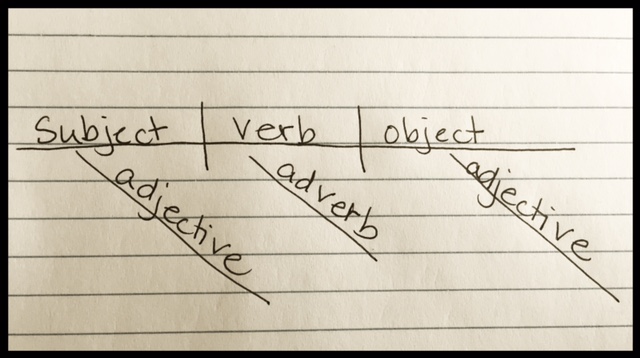This post may forever peg me as old, but here goes.
Do you know how to diagram a sentence? I used to. In middle school (well, in the 1980s suburbs of D.C. we called it “junior high”), we broke down many sentences into graphic representations. We put the subject on the left and the verb on the right (separated by a line) and any prepositional phrases or modifying clauses would hang down at an angle.

I have always been a grammar junkie, so my 13-year-old self loved this exercise. Unfortunately, my children have never diagrammed a sentence. It seems that the practice is disappearing, like many other word nerd related activities such as learning cursive and communicating via hand written letters. Before it dies completely, let me review the dying art of diagramming.
The History of Sentence Diagramming
The idea of diagramming sentences started way back in 1877 with two professors at Brooklyn Polytech Institute. Alonzo Reed and Brainerd Kellogg published a book called Higher Lessons in English in which they claimed students would write better if they could see the underlying structure of sentences.
The Reed-Kellogg method for diagramming sentences was popular in American education until the 1960s when new research questioned its value. By 1985, the National Council of English Teachers asserted that grammar drills, like diagramming sentences, were not helpful for teaching writing and could even hinder students’ ability to improve.
As a result, most students today don’t learn how to diagram sentences, which makes me sad. Critics of the practice say that diagramming a sentence complicates the learning process. Students forced to focus on the details of word and line placement in the diagram lose sight of the language and the writing. I guess I can understand how this extra layer of work detracts from learning grammar and improving writing skills.
However, I am a visual learner, and seeing the different parts of speech and how they relate to each other within a sentence fascinates me. I think diagrams could still be an effective tool to help students understand complex construction and parts of speech.
The website PopChartLab sells a chart of 25 opening lines from popular works of literature diagrammed according to the Reed-Kellogg system. Here’s my favorite:

Whoa. Even with all of my junior high practice, I’m not sure I could have done that one!
Despite the fact that diagramming sentences has fallen out of favor in education, there are many resources on the web to help you learn the skill. Check out:
- Diagramming Sentences
- Online Resources from a Homeschool Blog
- Diagramming movie from Brain Pop
- How to Diagram a Sentence from Huffington Post
With help from these sites, I figured out how to diagram this basic sentence:
Josh walks the dogs in the morning.

Thank you to this NPR article for the details on diagramming history.
Have you ever had to diagram a sentence? How could the exercise benefit or harm the writing process?
Did anyone else notice that the founder of sentence diagramming had a very academic name? Brainerd Kellogg? Brain – nerd? Wow!
Thanks for getting nerdy with me! (and Brainerd)



I was born in ’74 and we did learn sentence diagramming in public school in NYC back then. I think we learned it in elementary but it might have been in junior high. I clearly remember doing sentence diagramming but can’t recall in which class. I don’t recall hating it or loving it – we simply had to do it.
I have no problem reading and never have had a problem with it. I don’t think it would harm students unless taught in a confusing manner, which might put a student off. But, of course, ANY subject taught poorly can scare off a child trying to learn.
I currently homeschool my children, ages 9 and 5. I might teach diagramming. My daughters would probably think of it as a game or a fun kind of challenge, like a riddle – but then, that’s how we approach learning.
Nice! Thanks for visiting and adding to the discussion! 🙂
Hi! Thanks for your article, and bringing to light some of the joys of sentence diagramming to those who do not know about it. I do not remember learning to diagram in school (New York in the 70″s), which I think is surprising. However, I am now a teacher at a Hillsdale charter school, and included in the curriculum they give us to teach is grammar. Specifically, we use Well-Ordered Language – written by Tammy Peters and Daniel Coupland. This program has students diagramming starting in level 2, which is what I teach. It is so much fun to see students grasp this concept and use it well. I am amazed and impressed to see how well this improves their understand of how sentences are formed, and what each part of speech is doing in the sentence. Check out the program if you are interested to see what we are teaching in classical education these days!
Fascinating, Carrie! I will definitely look into this program. I love the idea of students understanding what role each word plays in the sentence. Hopefully this will help them communicate more effectively! Great tip. Thanks for sharing. 🙂
I wish there was more research about how diagramming impacts reading ability. It’s mentioned in LSAT prep courses to help students understand the logic of statements as well as improve reading comprehension. It would be nice to see studies that explore that impact.
I loved, loved diagramming sentences. I remember diagramming sentences in sixth grade, and as a visual learner, it helped me break down the sentence. Diagramming sentences is a lost art, just like the days when handwriting was a subject.
Your not alone in missing diagramming sentences. I may let my sixth graders have some fun and diagram some sentences on Monday!
Thanks for the article.
You are welcome, and thank you for letting me know I’m not alone. How did your sixth graders enjoy that diagramming lesson?
My excitement spilled over to them and once they got the concept…they didn’t want to stop! I am making diagramming worksheets for fun and also for extra credit.
Thanks again.
Hacienda
Wow, that’s so exciting! There’s something I find reassuring and comforting about creating order and structure. Maybe that’s the appeal… especially these days. Good for you and keep up the great teaching!
The reason you aren’t sure you could do the sentence from PopChartLab is because they diagrammed it wrong. Most of the diagrams on their site, that they sell, are diagrammed incorrectly.
Interesting. Can you recommend a site or reference with reliably correct sentence diagrams?
Good day! I like the way you put a bit of historical background of sentence diagramming, its purpose (for visual learner) as well as the link given pop chart lab. this is so informative, great for sharing. I will borrow your info just to share with my colleague in our M.A. class. Thank you ma’am Julia, mabuhay!
They didn’t teach sentence diagramming in public school, but I know they did in the Catholic schools in my area. And you and I are about the same age! It seems like a technique that I would have really loved and geeked out about.
I have vague memories of diagramming in middle school. I didn’t do it again until my first student teaching job when I shadowed a very old-school teacher who was hanging on to her methods like a man hangs on to a lifeboat…she was convinced that we were losing a generation of readers and writers if we didn’t teach it. I learned a lot from her!
*Brainard. That’s…interesting.
p.s. Off topic a bit, but check this out: https://www.theatlantic.com/magazine/archive/2017/09/has-the-smartphone-destroyed-a-generation/534198/
Holy crap, what an article! Thank you so much for sharing. I’ve seen a lot of this in the teens I know- luckily mine are still pretty independent… but we just told our daughter (a sophomore) that she couldn’t get a job during the school year. Am I falling into the trap?
Ouch, my poor brain! That pride & prejudice one is awesome 🙂 I never had to diagram a sentence~ I don’t even remember learning things like “pronoun” and “subjunctive” until I studied other languages!
Seriously?! Clearly, you are younger than I am. 😉 Well, it looks like you’ve done okay with your writing even though you never diagrammed. (PSST. Everyone, Jessica’s fourth book is coming out soon… Check it out on Jessica’s Blog Falling Leaflets)